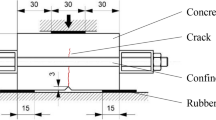Abstract
Three types of concrete with compressive strengths of about 45, 80 and 100 MPa are exposed in a loaded state in a closed container and subjected to a sequence of wetting by salt fog and drying. For each concrete, the measurements of chloride content on three prismatic specimens allow us: 1/ to study the profiles of chloride ingress into concrete, 2/ to compare the different results obtained in relation to the loading state of each specimen, and 3/ to calculate the apparent diffusion coefficient Da.
The results show the influence of concrete strength and the effect of the load applied on the penetration of chlorides into concrete. A linear relationship is found between the chloride’s apparent diffusion coefficient Da and the concrete strength. There is also a relationship between Da and the loading level. These relationships are established independently of the exposure period.
Résumé
Trois types de bétons de résistance à la compression de 45, 80 et 100 MPa sont conservés sous sollicitation mécanique dans une enceinte et soumis à des cycles alternés de pulvérisation par un brouillard salin et de séchage. Pour chaque béton, la mesure de la concentration des ions chlorures effectuée sur trois échantillons prismatiques, nous permet: 1/ de tracer les profils de pénétration des ions chlorures dans le béton, 2/ de comparer les résultats obtenus en fonction du niveau de chargement de chaque échantillon, 3/ de calculer le coefficient apparent de diffusion Da.
Les résultats font apparaître l’influence de la résistance en compression du béton et l’influence du chargement mécanique sur la pénétration des ions chlorures dans le béton. On trouve ainsi une relation linéaire entre le coefficient apparent de diffusion Da et la résistance en compression du béton. On établit également une corrélation entre Da et le niveau de sollicitation mécanique. Ces relations sont établies indépendamment du temps d’exposition.
Similar content being viewed by others
References
Stratfull, R.F.,Corrosion 3 (1957) 173–178.
Goni, S. and Andrade, C., ‘Synthetic concrete pore solution chemistry and rebar corrosion rate in the presence of chlorides’,C.C.R. 20 (1990) 525–539.
RILEM Technical Committee 124-SRC, ‘Draft recommendation for repair strategies for concrete structures damaged by reinforcement corrosion’,Mater. Struct. 27 (1994) 415–436.
Konin, A., François, R. and Arliguie, G., ‘Analysis of progressive damage of reinforced ordinary and high performance concrete’,Mater. Struct. 31 (1998) 27–35.
Ollivier, J.P., ‘A non destructive procedure to observe the microcracks of concrete by scanning electron microscope’,C.C.R 18 (1988) 35–43.
Wind, G. and Stroeven, P., ‘Chloride penetration into offshore concrete and corrosion risks’,ACI SP-100 2 (1987) 1679–1690.
‘Durability of Concrete Bridge Decks’, National Cooperative Highway Research Program, Synthesis of Highway Practice 57, Transportation Research Board, National Research Council, Washington, DC (1979).
Yssorche, M.P., ‘Microfissuration et Durabilité des BHP’, thèse de Doctorat INSA (1995)
Maage, M., Heeland, S. and Carlsen, J. E., ‘Service life prediction of high strength concrete in the “Shore Approach” structure’, Symposium on Utilization on High Strength-High Performance Concrete, Paris, May 1996.
François, R. and Maso, J.C., ‘Effect of damage in reinforced concrete on carbonation or chloride penetration’,Cement and Concrete Research 18 (1988) 961–970.
Konin, A., François, R. and Arliguie, G., ‘Influence of the service load on chloride penetration into reinforced HSC’, Proceedings of MRS Fall meeting, Boston, Nov.–Dec. 1995.
Gerard, B., Didry, O., Marchand, J., Breysse, D. and Hornain, H., ‘Modelling the long-term durability of concrete for radioactive waste disposals’, Proceedings of MRS Fall meeting, Nov.–Dec. 1996.
Carde, C. and François, R., ‘Ageing damage model of concrete behavior during the leaching process’,Mater. Struct. 30 (1997) 465–472.
BAEL 91, ‘Règles de calcul du béton armé aux états limites’, 1991.
François, R., Arliguie, G. and Maso, J.C., ‘Durabilité du béton armé soumis à l’action des chlorures’,Annales de l’ITBTP 529 (1994) 1–48.
Roy, S.K., Chye, L.K. and Northwood, D.O., ‘Chloride ingress into concrete as measured by field exposure test’,Cement and Concrete Research 27 (1993) 1289–1306.
Author information
Authors and Affiliations
Additional information
Editorial note Prof. Ginette Arliguie is a RILEM Senior Member. She is Chairlady of RILEM TC 163-TPZ (Interfacial Transition Zone and the Properties of Transfer) and a member of 154-EMC (Electrochemical Techniques for Measuring Metallic Corrosion).
Rights and permissions
About this article
Cite this article
Konin, A., François, R. & Arliguie, G. Penetration of chlorides in relation to the microcracking state into reinforced ordinary and high strength concrete. Mat. Struct. 31, 310–316 (1998). https://doi.org/10.1007/BF02480672
Received:
Accepted:
Issue Date:
DOI: https://doi.org/10.1007/BF02480672




